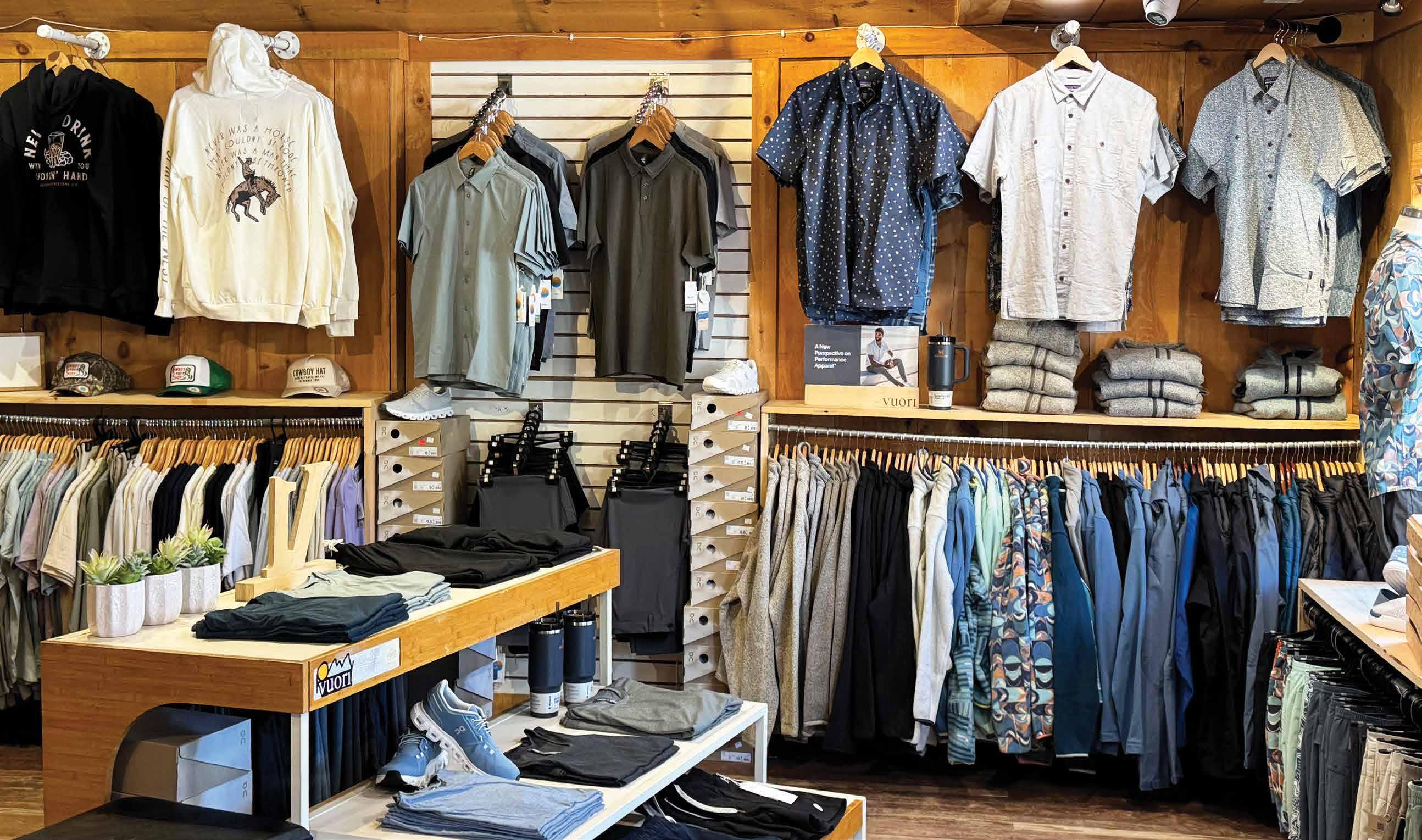
9 minute read
STRONG COMMITMENT
Blue Mountain Resort leads the charge in sustainability
words :: Carl Michener photos :: Rudy Jenkins
When Tori Rooney started a summer job on the ropes course at Blue Mountain Resort, she never expected it would lead her to a greater mission: spearheading the resort’s sustainability initiative.
Rooney now tackles everything from energy and food-waste reduction to vehicle efficiency, reducing the use of plastics, planting trees and many other tactics that together will help BMR meet its 2030 carbon commitments: reducing emissions by 50 per cent, offsetting the remaining emissions and using 100 per cent renewable energy.
“The roles I had at Blue—ropes, bartending, tubing, mountaintop skating—opened my eyes to areas where the resort could improve its sustainability,” she explains. “So, after earning a degree in environmental science from Queen’s University, I met with my BMR manager and director to present a vision that led to this role.”
Rooney’s plan appealed to BMR management, including President Dan Skelton. Knowing BMR’s parent company, Alterra, planned to develop a sustainability leads team spanning all resorts, Skelton took the initiative to develop the role internally, helping to kickstart an initiative organization-wide. Now sustainability is part of every decision BMR makes, with a focus on achieving their 2030 carbon commitments. “We’ve now done four years of greenhouse gas inventories resort-wide. Setting that baseline was important,” says Tori. “Seeing the data on paper paints a very different picture, and being able to calculate and analyze this data is super helpful.”
BMR is concentrating on reducing Scope 1 and 2 emissions, which are on-site operational emissions from vehicles and buildings, and electricity generation. The plan to reduce Scope 3 emissions (from guest travel, goods and waste transportation) is on the horizon.
Public transportation is an old-school green initiative, and BMR has its own internal network of complimentary shuttle buses that deliver employees and guests throughout the resort. And while BMR has only one electric vehicle—a car that assists retail outlets at the resort—it is considering other electrified vehicles and is moving to renewable diesel for machinery. In the meantime, under Tori’s watch BMR has installed a diagnostic system across its vehicle fleet. Sensors collect engine data and monitor idling, and the system flags vehicle fault codes and performs EV suitability assessments.
“This helps us determine which vehicles are underutilized and what fleet vehicles we truly need,” says Tori. “It also lets our mechanics know when to bring vehicles into the shop for maintenance.”
Wherever possible, new resort infrastructure focuses on electricity rather than natural gas. Because Hydro One electricity is 87.5 per cent renewable, reducing Scope 2 emissions by increasing the electricity quotient makes green sense for BMR. Many other ski resorts, especially in the Rockies, tap into electricity grids that aren’t as clean.
Other possible on-resort plans include transitioning to electric vehicles, building to net-zero standards and implementing a longerterm on-hill management plan.
BMR already has several wins on the books, such as yearover-year efficiency gains in snowmaking thanks to analytics and automation. And the resort’s biggest transformers are already enrolled in Hydro One’s Industrial Conservation Initiative, a demand-response program aimed at shifting large electricity users’ consumption to off-peak hours. Because peak energy demands are during the winter for snowmaking, it’s an easy win for the environment and the balance sheet.
The resort currently diverts more than 37 per cent of waste from the landfill through various reduce, reuse and recycle initiatives and is aggressive about driving that number up. BMR also purchases their receipt paper from EcoChit, a company that in turn works with Veritree to plant mangrove trees (which have a high carbon sequestration rate) in Kenya and Madagascar. “It’s a first step,” says Rooney. “Building a portfolio of high-quality offsets will be an Alterra head office initiative as we get closer to 2030.”
You know those Blue Mountain 5x7 passes that used to arrive in the mail each year? Season passes have now become reloadable, which means many thousand fewer plastic cards. But a much greater impact is coming from a deep dive into food waste.
“I love using technology to make sustainability solutions,” Rooney enthuses. “That’s how I would describe our current pilot of an AI-powered food waste tracking system.” The Swiss-made system consists of a scale with a camera that captures images of food waste. It identifies how much food is being wasted and precisely what type. System analytics have already delivered results: Restaurants serve too many fries, most guests don’t eat their second slice of toast, and garnishes like orange slices usually get thrown away.
“Based on the data, we’ve adjusted portion sizes and ingredients,” says Tori. The next phase for the tracking system will take place in the Village Conference Centre, where food-waste data can be associated with each group. “The system can inform us of meal preferences during a visit, so the following year we can tailor a menu to offer specific items and proportions for that group.”
Composting food waste at conference centres is not difficult, but cafeterias present a different set of challenges. To ensure cafeteria leftovers actually get composted, BMR has reorganized the waste station in Grand Central Eatery, giving guests a map of what to do with what’s left on their trays.
“You put your tray down and move along this conveyor belt of images,” says Rooney. “You pour out your drink. Then you dump the compost. Then it moves to container recycling and finally to waste.” Ideally, guests will dispose of the right item in the right area, resulting in the least amount of waste possible. As the system is replicated across all base lodges, guests will learn how to use the system efficiently.
Initiatives are important, but employee buy-in is just as crucial. To ensure sustainability behaviour filters down to BMR’s 1,200 employees, the resort created a culture committee composed of a representative from each department. Three subcommittees include wellness, sustainability and social responsibility. Two co-chairs for sustainability now work in lodging and the snow school.
“For me, seeing our team embrace and amplify the sustainability message across the resort is incredible,” says Rooney. As for the future, she’s unwavering in her vision. “We’ll meet our goals—and then we’ll go even further.”


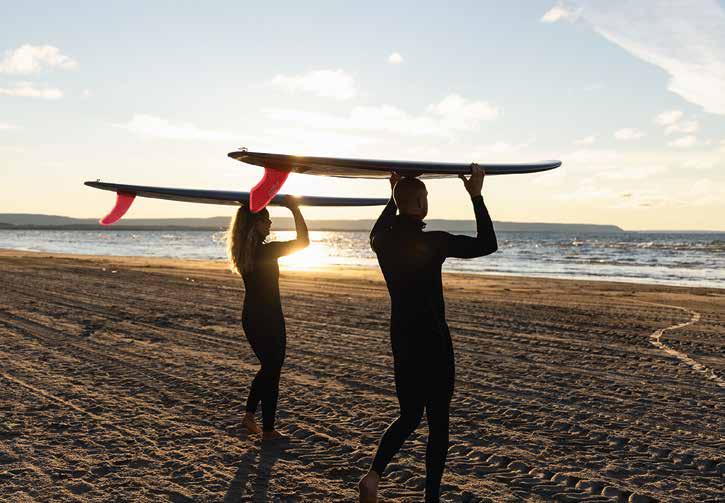



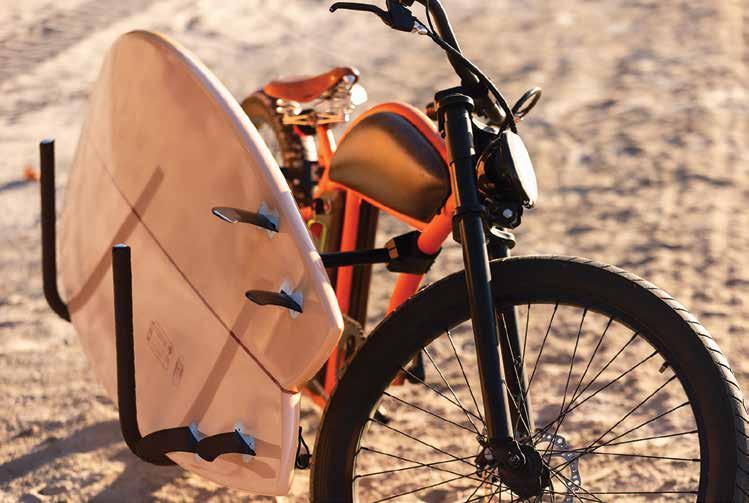



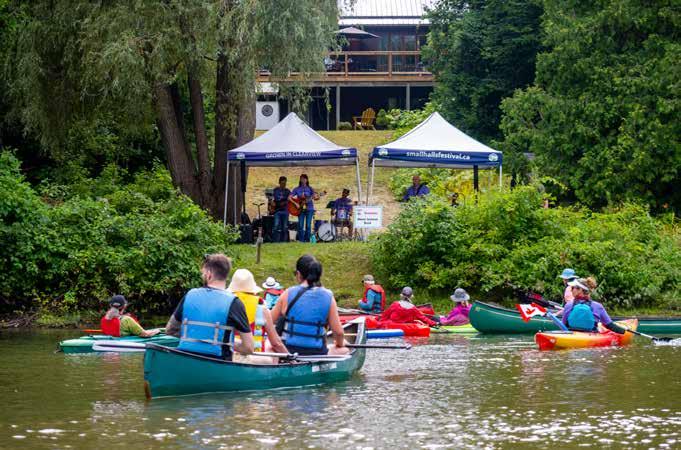
ROCKIN’ THE RIVER IS BACK
Born from a combined love of music and paddling, the fifth annual Free Spirit Tours Rockin’ The River event is back this year, bigger and better than ever.
On Saturday, August 9, bright flotillas of kayaks, canoes and SUPs will head out from Klondike Sports Park in Wasaga Beach for a four-hour paddle down the Nottawasaga River. Along the route, ten bands entertain paddlers as they float by, headed for a final band and bash at Free Spirit headquarters.
“The vibe is amazing!” says Free Spirit co-owner Jennie Elmslie. “The bands are having so much fun, too. It’s such a unique way to spend a day on the river!”
For the 2025 edition, they’ve added a fresh list of musicians—and a new stop at Oxbow Dunes, a favourite among paddlers. Spots sell out quickly, so head to www.rockintheriver.ca to learn more.
Georgian Bay Cycle For Hope
On Saturday, August 16, the Cycle For Hope returns—and this year, it’s bigger than ever, with events in both Collingwood and Penetanguishene.
What began quietly 14 years ago has become the Georgian Bay Cancer Support Centre’s (GBCSC) biggest annual fundraiser, raising close to $700,000 to date. “Everyone who takes part knows how much the funds raised that day make a difference for those impacted by cancer in our community,” says Paul Eichhorn, the fundraising and stewardship manager at GBCSC.
Routes range from the family-friendly Ice Cream Route (great for riding or walking) to longer distances for more experienced riders, and participants can expect scenic rides through rolling backroads. As Eichhorn says, “There’s something for everyone who wants to get involved in the Cycle For Hope for a good cause.”
Last year saw 272 riders climb onto the saddle, and organizers are expecting more than 400 participants this year. Whether you ride, roll, or walk, it’s a day of celebration, connection, and making a real impact for those in need across Southern Georgian Bay and North Simcoe. Learn more and register at www.gbcycleforhope.ca.
WATER BORNE: A SUP EXPLORATION OF BLUE SPACE

Water Borne is like a fresh breeze off the Great Lakes: bracing and perspectiveshifting. The new book by longtime ML contrib Dan Rubinstein traces his solo 1,900-kilometre paddleboard loop voyage through rivers, lakes and canals from Ottawa to New York City and back via Toronto. Calling the mission “solo” is misleading, for though Dan is mostly paddling alone, the book focuses on the people he meets on the way including scientists, sailors, nonprofit managers, municipal employees, canal lock tenders, dockside bartenders and all sorts of regular citizens living near water. These encounters underpin the book’s exploration of water (and proximity to it) as both a boon to mental and physical health and an opportunity for human connection. In an age where that connection often feels broken, the book offers an alternative: Water is a unifier. – Ned Morgan
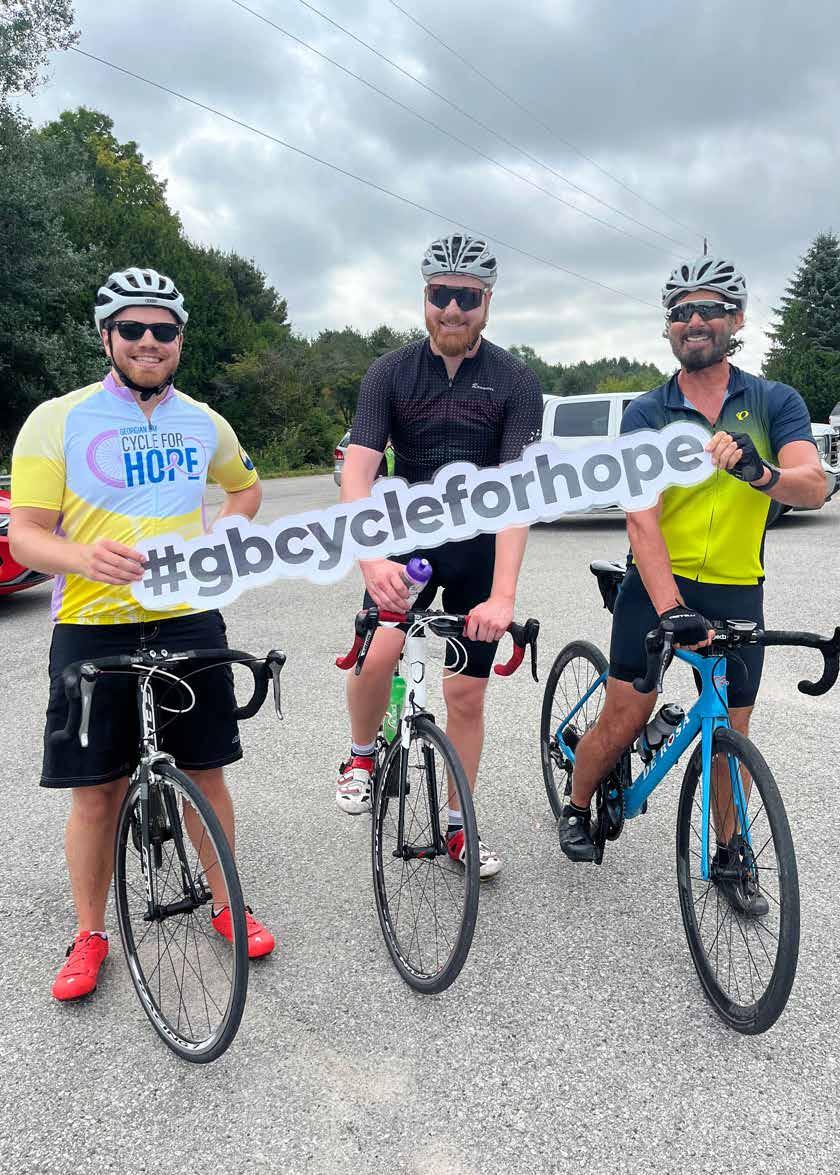
Hit The Trails And Run For Her
Ovarian cancer is one of the most fatal forms of cancer affecting women, taking the lives of five Canadians every day. Alicia Tone, Collingwood local and the director of research at Ovarian Cancer Canada (OCC), has extended her passion beyond the lab to found Run For Her, an annual trail-running event that raises funds for ovarian cancer research.

“It started as a solo run in 2020,” says Tone. “But the next year I shared my plans on social media and friends messaged me saying they wanted to join in. Since then, it has organically grown each year through word of mouth and a growing sense of community involvement.”
After last year’s stellar turnout of nearly 100 runners and walkers, Run For Her has raised $68,164 to date for OCC. Every penny raised goes directly to the organization.
This year Tone has upped her game with paper maps, increased trail marking, a streamlined registration and donation process and more on-site amenities. The fun starts just after sunrise on Saturday, September 27, at Three Stage, with four route options: five, 10, 20 or 31 kilometres. Walk or run, go solo or with a team—or just bring your best noisemaker and costume to encourage participants as an aid-station or navigational volunteer.
With the sixth-annual event gearing up to be the biggest yet, Tone is looking forward to the on-site vibe as much as the fundraising results. “Patient advocates have played a key role in this event since 2022 and are always so touched by the collective energy and generosity of the participants,” she says. “Participants have shared that they love the unique combination of fun along with the rewarding feeling of pushing themselves, and there’s an overwhelming sense of doing something good as a community. Last year I had to take a moment before the run started to take it all in—it is such a special day.”
Registration opens June 1, and sponsorship opportunities are still available. Learn more and get involved at www.runforher.ca.
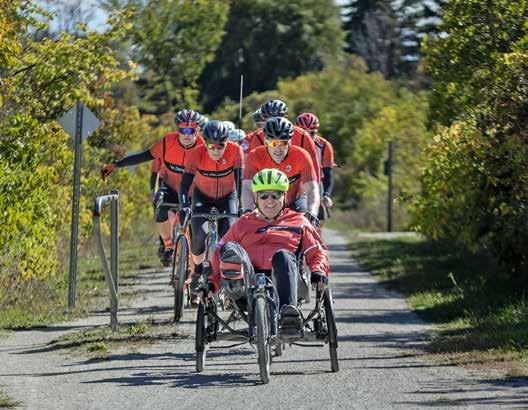
THE GROWLING BEAVER FOR PARKINSON’S
On October 4, cyclists will once again gather for one of Canada’s most scenic fall rides: The Growling Beaver. Starting and finishing at Side Launch Brewing Company in Collingwood, this annual fundraising event is a powerful way to support Canadians living with Parkinson’s.
“This year marks our 11th annual Growling Beaver fundraiser,” says Scott McMillan, Parkinson Canada’s director of events. “Last year was our biggest ride yet with 295 riders and $695,000 raised for people living with Parkinson’s in Canada. We look forward to building on that success and continuing to watch this ride grow and become one of the pre-eminent cycling events in Canada.”
New this year: a 60-km road route and a refined 160-km gravel route, plus pro announcers, finish-line celebrations and a raffle for a fully customized bike worth nearly $20,000. Volunteers are needed for everything from registration to checkpoint management, so whether you’re riding or helping out, there’s a place for you.
Visit www.pedalingforparkinsons.ca to learn more about the Growling Beaver and register as a rider or volunteer.
SUPPORT YOUTH AT THE TEAM GIVE’R KENNETH’S WALK
Created to honour the late Kenneth McAlpine, the Team GIVE’R Foundation supports youth and young adults in both Collingwood and Rossland, BC, providing access and programming in skiing, athletics and culinary arts.
The annual Kenneth’s Walk event is an incredible opportunity to support the foundation while sampling some of the area’s best fare. Slated for September 20 at Duntroon Highlands, the 5th annual Kenneth's Walk combines a meander through the woods with chef tastings, followed by an after-party celebration at the Highlands House—complete with appreciation speeches, silent auction, raffle prizes and presentations from last year’s grant recipients.
Kenneth’s energy was contagious, whether he was coaching ski teams, mentoring young chefs or inspiring Canadians on The Amazing Race Canada. “He was the most caring person I knew on this planet and the ultimate best friend a guy could ask for,” says Ryan Lachapelle, executive director and founder of the Team GIVE’R Foundation. “He lived his life devoting himself to his friends, family, faith and community.”
Last year’s walk was a huge success, and the 2025 event promises to be even better—thanks to the chefs, craft beverage suppliers, sponsors, volunteers and community members who keep Kenneth’s spirit alive.
Tickets sell out quickly, so get yours in advance at www.teamgiver.ca/events.
